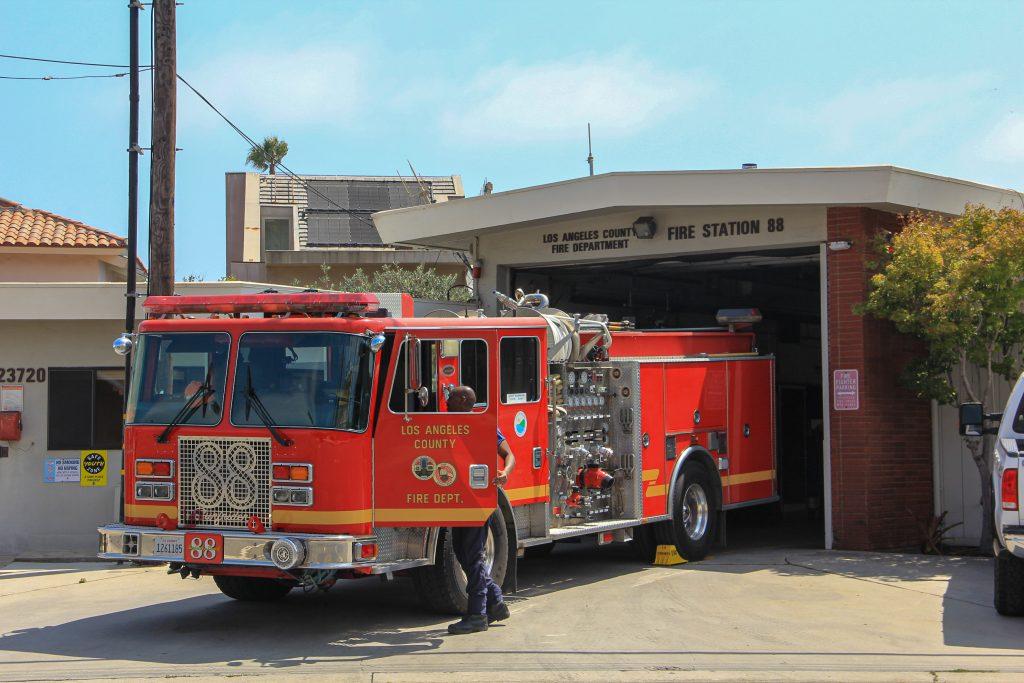A firefighter at the LA County Fire Department (LACoFD) Station 88 in Malibu climbs into a fire engine Aug. 13. LACoFD Fire Captain Alex Abdalla said the first engine on scene during the Franklin and Palisades fires was from Station 88. Photo by Melissa Houston
The length of California’s burn season has increased over the past two decades, according to a report by the UC Irvine Department of Civil and Environmental Engineering.
In the aftermath of the fires, officials from the Malibu Department of Public Safety and the Los Angeles County Fire Department (LACoFD) said they were planning on a general expansion of their resources. Malibu, in particular, is addressing specific aspects of communication and prevention regarding wildfires, according to officials.
These agencies are expanding upon their already proactive approach.
“My crew has definitely been battle-tested over this last fire season,” said Alex Abdalla, fire captain of LA County Fire Station 88.
Communication, Readiness, Response and Recovery
Susan Duenas, director of the Malibu Department of Public Safety, said a lesson learned in her agency during the fires was staffing needs to become more strategic to relieve pressure across the city’s public safety team. Documentation is essential to speed up recovery, a duty for which an additional staff member is being trained.
“Under the conditions, all the city staff did a phenomenal job,” Duenas said.
Two people read an information board outside Malibu City Hall on Aug. 12. Susan Duenas, director of the Malibu Department of Public Safety, said the building was evacuated during the recent fires. Photo by Melissa Houston
The Malibu Department of Public Safety had recently acquired radios just before the fires, marking a drastic improvement in Malibu’s strategy, Duenas said. During the Woolsey Fire, there was a communication blackout between the community and the city’s emergency center because neither group had radios.
Malibu is also testing a new initiative to notify residents in vulnerable areas via pagers, Duenas said.
They are also collaborating with Firewise, a program run by the National Fire Prevention Association that helps reduce the risk of destruction by wildfires. Duenas also said the number of Firewise communities within Malibu has grown from 2 to 13 over the past year and a half.
To address the lengthening fire season, LACoFD uses tools like the National Fire Danger Rating System, which assesses burning conditions in a given area and helps coordinate response to wildfire incidents, according to the Department of Agriculture’s website.
Changes in the technology — such as fire modeling, alert wildfire cameras and remote weather stations— will allow them to track weather conditions in real-time, LACoFD Assistant Chief Drew Smith said.
“When we get a wind event like that [Santa Ana winds], we get a start, we show up on scene, and it is so well established in the very beginning: ‘it’s only going to get bigger’ really is the mindset,” Abdalla said.
Abdalla said they regularly work with the Pepperdine Department of Public Safety.
“I only have positive things to say about Pepperdine and our working relationship with them, and I look forward to continuing that relationship,” Abdalla said.
Regarding Pepperdine, Abdalla said it is not feasible to evacuate all students during a brush fire.
“Students need to know that those evacuation areas — such as the library — have been battle-tested during the most austere circumstances,” Abdalla said.
Firefighters from a neighboring department overlook Pepperdine’s Malibu campus after the Franklin Fire on Dec. 11. Abdalla said he was briefly the task force commander for the campus during the fire. Photo courtesy of Liam Zieg
During the Franklin and Palisades fires, many residents stayed behind to defend their homes.
“One thing that we cannot have is to advocate for people to stay and defend their home, because it worked the last time,” Smith said.
Smith said adhering to evacuation guidance early is key, as waiting until the last minute limits residents’ options.
Abdalla said he understood residents staying to defend their homes, but most lack the experience to put themselves in a good situation while doing so. The problem that arises from these situations is that they create problematic evacuations for firefighters responding to the wildfire.
Effectiveness of the CERT Program
One way for community members to become more involved is through the Community Emergency Response Team (CERT), a FEMA-sponsored initiative to educate volunteers for disaster response and preparedness, according to the FEMA website.
“We really saw it [CERT] work in Woolsey, and we’ve been doubling down on it ever since then,” Duenas said.
Duenas said they are going to keep trying to expand the role of the CERT team, which was instrumental in repopulating Malibu after the recent fires.
“The reminder is that things can quickly change, and to always have a plan in place,” Abdalla said.
__________________
Follow the Graphic on X: @PeppGraphic
Contact Oliver Evans via email: oliver.evans@pepperdine.edu




